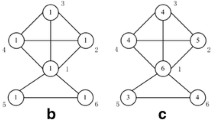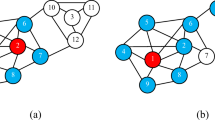Abstract
In online social networks, there are some influential opinion leader nodes who can be used to accelerate the spread of positive information and suppress the diffusion of rumors. If these opinion leaders can be identified timely and correctly, there will be contributing to guide the popular opinions. The closeness is introduced for mapping the relationship between the nodes according to the different interaction types in online social network. In order to measure the impact of the information transmission between non-adjacent nodes in online social networks, a closeness evaluating algorithm of the adjacent nodes and the non-adjacent nodes is given based on the relational features between users. By using the algorithm, the closeness between the adjacent nodes and the non-adjacent nodes can obtained depending on the interaction time of nodes and the delay of their hops. Furthermore, a more accurate and efficient betweenness centrality scheme based on the optimized algorithm with the degree of closeness and the corresponding updating strategy. The opinion leader nodes should be identified more accurately and efficiently under the improved algorithm because the considering of closeness between nodes in the network. Finally, the maximum spreading experiment is done for comparing the proposed method with other existing identifying opinion leader selecting schemes based on the Independent Cascade Model. The result of experiment shows the effectiveness and practicality of the evaluating algorithm.











Similar content being viewed by others
References
Bader DA, Kintali S, Madduri K, Mihail M (2007) Approximating betweenness centrality. In: Bonato A, Chung FRK (eds) Algorithms and models for the web-graph. Springer, San Diego, pp 124–137
Bakshy E, Karrer B, Adamic LA (2009) Social influence and the diffusion of user-created content. In: Proceedings of the 10th ACM conference on electronic commerce, ACM, pp 325–334
Bonacich P (2007) Some unique properties of eigenvector centrality. Social Netw 29(4):555–564
Brandes U (2001) A faster algorithm for betweenness centrality*. J Math Sociol 25(2):163–177
Brandes U (2008) On variants of shortest-path betweenness centrality and their generic computation. Social Netw 30(2):136–145
Catanese S, Ferrara E, Fiumara G (2013) Forensic analysis of phone call networks. Social Netw Anal Min 3(1):15–33
Domingos P, Richardson M (2001) Mining the network value of customers. In: Proceedings of the seventh ACM SIGKDD international conference on Knowledge discovery and data mining, ACM, pp 57–66
Freeman LC (1977) A set of measures of centrality based on betweenness. Sociometry 40(1):35–41
Freeman LC (1978) Centrality in social networks conceptual clarification. Social Netw 1(3):215–239
Fu Z, Sun X, Linge N, Zhou L (2014) Achieving effective cloud search services: multi-keyword ranked search over encrypted cloud data supporting synonym query. IEEE Trans Consum Electron 60(1):164–172
Fu Z, Ren K, Shu J, Sun X (2016) Enabling personalized search over encrypted outsourced data with efficiency improvement. IEEE Trans Parallel Distrib Syst 27(9):2546–2559
Granovetter MS (1973) The strength of weak ties. Am J Sociol 78(6):1360–1380
Guo P, Wang J, Geng XH, Kim CS, Kim JU (2014) A variable threshold-value authentication architecture for wireless mesh networks. J Internet Technol 15(6):929–935
Holme P, Kim BJ, Yoon CN, Han SK (2002) Attack vulnerability of complex networks. Phys Rev E 65(5):056,109
Kempe D, Kleinberg J, Tardos É (2003) Maximizing the spread of influence through a social network. In: Proceedings of the ninth ACM SIGKDD international conference on knowledge discovery and data mining, ACM, pp 137–146
Kitsak M, Gallos LK, Havlin S, Liljeros F, Muchnik L, Stanley HE, Makse HA (2010) Identification of influential spreaders in complex networks. Nat Phys 6(11):888–893
Li J, Chen X, Li M, Li J, Lee PPC, Lou W (2013) Secure deduplication with efficient and reliable convergent key management. IEEE Trans Parallel Distrib Syst 25(6):1615–1625
Li J, Huang X, Li J, Chen X (2014) Securely outsourcing attribute-based encryption with checkability. IEEE Trans Parallel Distrib Syst 25(8):2201–2210
Li J, Li J, Chen X, Jia C, Lou W (2015) Identity-based encryption with outsourced revocation in cloud computing. IEEE Trans Comput 64(2):425–437
Lu Z, Fan L, Wu W, Thuraisingham B, Yang K (2014) Efficient influence spread estimation for influence maximization under the linear threshold model. Comput Soc Netw 1(1):1–19
Newman ME, Watts DJ (1999) Renormalization group analysis of the small-world network model. Phys Lett A 263(4):341–346
Onnela JP, Saramäki J, Hyvönen J, Szabó G, Lazer D, Kaski K, Kertész J, Barabási AL (2007) Structure and tie strengths in mobile communication networks. Proc Natl Acad Sci 104(18):7332–7336
Putzke J, Takeda H (2016) Identifying key opinion leaders in evolving co-authorship networksa descriptive study of a proxy variable for betweenness centrality. In: Cherifi H, Gonçalves B, Menezes R, Sinatra R (eds) Complex networks, vol VII. Springer, Switzerland, pp 311–323
Qin Y, Ma J, Gao S (2016) Efficient influence maximization under TSCM: a suitable diffusion model in online social networks. Soft Comput 1–12. doi:10.1007/s00500-016-2068-3
Richardson M, Domingos P (2002) Mining knowledge-sharing sites for viral marketing. In: Proceedings of the eighth ACM SIGKDD international conference on knowledge discovery and data mining, ACM, pp 61–70
Sabidussi G (1966) The centrality index of a graph. Psychometrika 31(4):581–603
Said YH, Wegman EJ, Sharabati WK, Rigsby JT (2008) Retracted: social networks of author-coauthor relationships. Comput Stat Data Anal 52(4):2177–2184
Saito K, Nakano R, Kimura M (2008) Prediction of information diffusion probabilities for independent cascade model. In: Lovrek I, Howlett RJ, Jain LC (eds) Knowledge-based intelligent information and engineering systems. Springer, Croatia, pp 67–75
Segarra S, Ribeiro A (2014) A stable betweenness centrality measure in networks. In: 2014 IEEE international conference on acoustics, speech and signal processing (ICASSP). IEEE, pp 3859–3863
Shen J, Tan H, Wang J, Wang J, Lee S (2015) A novel routing protocol providing good transmission reliability in underwater sensor networks. J Internet Technol 16(1):171–178
Wang M, Ma J (2015) A novel recommendation approach based on users weighted trust relations and the rating similarities. Soft Comput 1–10. doi:10.1007/s00500-015-1734-1
Watts DJ, Strogatz SH (1998) Collective dynamics of small-world networks. Nature 393(6684):440–442
Xia Z, Wang X, Sun X, Wang Q (2015) A secure and dynamic multi-keyword ranked search scheme over encrypted cloud data. IEEE Trans Parallel Distrib Syst 27(2):1–1
Zhang Z, Wang K (2013) A trust model for multimedia social networks. Social Netw Anal Min 3(4):969–979
Acknowledgments
We would like to thank the anonymous reviewers for their careful reading and useful comments. This work was supported by the National Natural Science Foundation of China (U1405255, 61202390), the China 111 Project (B16037), the Foundation of Science and Technology on Information Assurance Laboratory (KJ-14-109) and the Fundamental Research Funds for the Central Universities (JB161505).
Author information
Authors and Affiliations
Corresponding author
Ethics declarations
Conflict of interest
Li Yang, Yafeng Qiao, Zhihong Liu, Jianfeng Ma and Xinghua Li declare that there are no conflict of interest.
Ethical approval
This article does not contain any studies with human participants or animals performed by any of the authors.
Additional information
Communicated by V. Loia.
Rights and permissions
About this article
Cite this article
Yang, L., Qiao, Y., Liu, Z. et al. Identifying opinion leader nodes in online social networks with a new closeness evaluation algorithm. Soft Comput 22, 453–464 (2018). https://doi.org/10.1007/s00500-016-2335-3
Published:
Issue Date:
DOI: https://doi.org/10.1007/s00500-016-2335-3




